VMware has announced its latest update to version 5.5 of its global virtualisation powerhouse, vCloud Suite.
To read the updates for all the suite components, see my post: What’s New in vCloud Suite 5.5: Introduction
 vCenter SSO gets one of the major updates. This is welcome news to anyone who installed SSO in vSphere 5.1 which was plagued with an overly complex and restrictive design. SSO in 5.1 was apparently an OEM component which VMware customised. SSO in 5.5 has been completely rewritten from the ground up internally.
vCenter SSO gets one of the major updates. This is welcome news to anyone who installed SSO in vSphere 5.1 which was plagued with an overly complex and restrictive design. SSO in 5.1 was apparently an OEM component which VMware customised. SSO in 5.5 has been completely rewritten from the ground up internally.
Evolving vCenter is a major undertaking as it was originally built as a monolithic platform with everything included in one place. VMware’s strategy is to pull out all the core central services from vCenter and have them run stand-alone.
In the future, vCenter may not in fact be the only management option. I can think of other future management options such as OpenStack or even Microsoft System Center or some other partner management ecosystem, all obviously at cloud scale. Today SSO has been re-built to scale serving vCloud Director, vCenter Orchestrator and Horizon View.
What’s New:
The whole architecture has been redesigned with a multi-master model with built-in replication both between and within sites. There are no longer primary and secondary SSO servers. Site awareness is part of the design, you can add new sites and SSO can be aware of the original site.
Read more…
Categories: ESX, Update Manager, vCenter, vCloud Director, vCOPS, View, VMware, VMworld Tags: esx, esxi, SSO, vCD, vcenter, vcops, view, vmware, vmworld
VMware has announced its latest update to version 5.5 of its global virtualisation powerhouse, vCloud Suite.
To read the updates for all the suite components, see my post: What’s New in vCloud Suite 5.5: Introduction
vCenter Server has been tweaked with this upgrade keeping its two deployment options, installed on a Windows Server or as an appliance.
VMware is strongly recommending using a single VM for all vCenter Server core components (SSO, Web Client, Inventory Service and vCenter Server) or to use the appliance rather than splitting things out which just add complexity and makes it harder to upgrade in the future.
What’s New:
vCenter
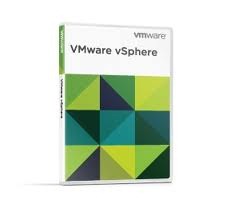 vCenter 5.5 on Windows has been made much more efficient with many performance improvements in the database and overall system. vCenter 5.5 on Windows now supports up to 1,000 hosts and 10,000 VMs. The vCenter Appliance has also been beefed up and with its embedded database supports 500 hosts and 5000 VMs or if you use an external Oracle DB (No MSSQL support planned) the supported hosts and VMs are the same as for Windows.
vCenter 5.5 on Windows has been made much more efficient with many performance improvements in the database and overall system. vCenter 5.5 on Windows now supports up to 1,000 hosts and 10,000 VMs. The vCenter Appliance has also been beefed up and with its embedded database supports 500 hosts and 5000 VMs or if you use an external Oracle DB (No MSSQL support planned) the supported hosts and VMs are the same as for Windows.
The vCenter 5.5 installation has changed the order of the simple install from 5.1 by swapping the order of the Web Client and Inventory Service installations so you have the Web Client available earlier on in the install chain for troubleshooting if something goes wrong.
IBM DB2 is no longer supported as a database for vCenter Server 5.5.
Read more…
Categories: ESX, Update Manager, vCenter, vCloud Director, vCOPS, View, VMware, VMworld Tags: esxi, vcenter, vmware, vmworld

 VMware has announced its latest update to version 5.5 of its global virtualisation powerhouse, vCloud Suite.
VMware has announced its latest update to version 5.5 of its global virtualisation powerhouse, vCloud Suite.
I would say that this is an evolutionary rather than revolutionary update being the third major release in the vSphere 5 family (5.0,5.1,5.5).
There are however some significant storage additions such as Virtual SAN (VSAN) and VMware Virtual Flash (vFlash) as well as a new vSphere App HA to provide application software high availability which is in addition to vSphere HA.
VMware has also responded to the customer frustration over Single-Sign on (SSO) which is an authentication proxy for vCenter and made some changes to SSO to hopefully make it easier to deploy. Every component of the suite has been updated in some way which is an impressive undertaking to get everything in sync.
Here are all the details:
- What’s New in vCloud Suite 5.5: Introduction
- What’s New in vCloud Suite 5.5: vCenter Server and ESXi
- What’s New in vCloud Suite 5.5: vCenter Server SSO fixes
- What’s New in vCloud Suite 5.5: Virtual SAN (VSAN)
- What’s New in vCloud Suite 5.5: VMware Virtual Flash (vFlash)
- What’s New in vCloud Suite 5.5: vCloud Director
- What’s New in vCloud Suite 5.5: vCenter Orchestrator
- What’s New in vCloud Suite 5.5: vCloud Networking & Security
- What’s New in vCloud Suite 5.5: vSphere App HA
- What’s New in vCloud Suite 5.5: vSphere Replication and vCenter Site Recovery Manager
VMware is certainly evolving their strategy of the software defined data center, this release puts software defined storage (SDS) on the map at least from a VMware perspective, a multi-year project. VMware vVolumes hasn’t made it into this release which shows what a major undertaking it is, we will have to wait for vSphere 6!
SDS is going to have a huge push this year from VMware and of course all the other storage vendors, expect some exciting innovation.
Software defined networking is the next traditional IT infrastructure piece to “Defy convention” and is arguably by far the hardest one to change. Another multi-year project is just beginning.
Categories: ESX, Update Manager, vCenter, vCloud Director, vCOPS, View, VMware, VMworld Tags: esx, esxi, networking, storage, UpdateManager, vCD, vcenter, vcops, view, vmware, vmworld

The official VMworld Barcelona session catalogue was huge and full of VMware sanctioned content. However running in parallel there was a fantastic community run fringe event.
The #vBrownBag guys stepped up to the plate and spent a lot of personal time to put together a whole series of short Tech Talks where anyone with something to say could have the spotlight.
Now, this wasn’t some soap box in the corner of a room with some nutters yelling into a megaphone but a super organised, livestreamed sponsored event with some serious content.
There were VMware employees and engineers talking about how you can run some seriously awesome yet unsupported VMware configurations as well as some seriously brainy and very highly regarded community members who have a passion for virtualisation and in their own time put together presentations that they thought the VMware community would be interested in.
Luckily these were all recorded so you can take some time out and see for yourself what the VMware community has to contribute.
Read more…
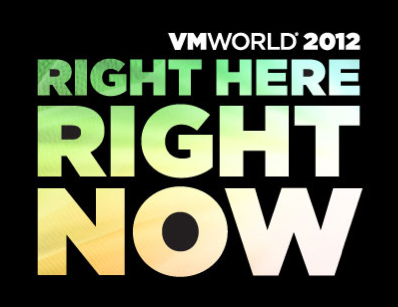 VMware’s US mega conference, VMworld kicks off in San Francisco in just over 2 weeks time. 19000 people attended in Las Vegas last year (we will have to see whether the choice of venue affects the numbers for this year!)
VMware’s US mega conference, VMworld kicks off in San Francisco in just over 2 weeks time. 19000 people attended in Las Vegas last year (we will have to see whether the choice of venue affects the numbers for this year!)
This will be my first time attending VMworld US as living in London I have attended VMworld Europe previously so am excited to see the differences, enjoy the bigger conference and meet some more fellow vExperts and other community members.
There’s obviously a huge amount that goes on at the conference from the keynote speaches, breakout sessions, panel discussions, labs, formal and informal meetings, and general networking so working out what to actually see with so much going on is harder than many people would assume.
Read more…
Categories: ESX, vCenter, vCloud Director, vCOPS, VDI, VMworld Tags: networking, storage, vCD, vcenter, vdi, vmware, vmworld
This is part 6 of a 7 part post on managing vSphere 5 Certificates:
- Installing a Root Certificate Authority
- Distributing the root CA certificate to clients
- Creating the default vCenter 5 Server Certificate and including a DNS alias
- Replacing the default vCenter 5 Server Certificate
- Replacing the default vCenter 5 Web Client Server Certificate
- Replacing the default vCenter 5 Inventory Service Certificate
- Replacing the default vSphere Update Manager 5 Server Certificate
vCenter Server actually has three different components which need their certificates updated, vCenter Server, vCenter Web Client Server and vCenter 5 Inventory Service. Initially I had only written the vCenter Server certificate steps but luckily Michael Webster (VCDX #66) keeps me on my toes and I’ve now added parts for the other two components.
You should have now created the default vCenter 5 server certificate files, replaced the default vCenter 5 Server certificate, replaced the vCenter 5 Web Client Server certificate and can now go ahead and replace the vCenter 5 Inventory Service Certificate with the same new certificate files you have created.
On the vCenter Server navigate to C:\Program Files\VMware\Infrastructure\Inventory Service\ssl.
Make a backup copy of the SSL folder.

Copy the rui.crt, rui.key and rui.pfx files from C:\OpenSSL-Win64\bin into the into the vCenter Inventory Service SSL folder

Read more…
This is part 5 of a 7 part post on managing vSphere 5 Certificates:
- Installing a Root Certificate Authority
- Distributing the root CA certificate to clients
- Creating the default vCenter 5 Server Certificate and including a DNS alias
- Replacing the default vCenter 5 Server Certificate
- Replacing the default vCenter 5 Web Client Server Certificate
- Replacing the default vCenter 5 Inventory Service Certificate
- Replacing the default vSphere Update Manager 5 Server Certificate
vCenter Server actually has three different components which need their certificates updated, vCenter Server, vCenter Web Client Server and vCenter 5 Inventory Service. Initially I had only written the vCenter Server certificate steps but luckily Michael Webster (VCDX #66) keeps me on my toes and I’ve now added parts for the other two components.
You should have now created the default vCenter 5 server certificate files, replaced the default vCenter 5 Server certificate and can now go ahead and replace the vCenter 5 Web Client Server Certificate with the same new certificate files you have created.
On the vCenter Server navigate to C:\Program Files\VMware\Infrastructure\vSphere Web Client\DMServer\config\.
Make a backup copy of the SSL folder.

Copy the rui.crt, rui.key and rui.pfx files from C:\OpenSSL-Win64\bin into the into the vCenter Web Client Server SSL folder

Read more…
This is part 4 of a 7 part post on managing vSphere 5 Certificates:
- Installing a Root Certificate Authority
- Distributing the root CA certificate to clients
- Creating the default vCenter 5 Server Certificate and including a DNS alias
- Replacing the default vCenter 5 Server Certificate
- Replacing the default vCenter 5 Web Client Server Certificate
- Replacing the default vCenter 5 Inventory Service Certificate
- Replacing the default vSphere Update Manager 5 Server Certificate
vCenter Server actually has three different components which need their certificates updated, vCenter Server, vCenter Web Client Server and vCenter 5 Inventory Service. Initially I had only written the vCenter Server certificate steps but luckily Michael Webster (VCDX #66) keeps me on my toes and I’ve now added parts for the other two components.
You should have now created the default vCenter 5 server certificate files and can now go ahead and replace the existing certificate for vCenter 5 Server with the new certificate files you have created.
On the vCenter Server navigate to C:\ProgramData\VMware\VMware VirtualCenter.
Make a backup copy of the SSL folder.
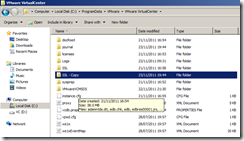
Copy the rui.crt, rui.key and rui.pfx files from C:\OpenSSL-Win64\bin into the into the vCenter SSL folder
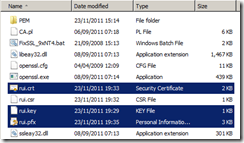
Read more…
VMware vCenter Operations Management Suite has been released today. This was the major announcement and focus of VMworld Europe 2011 which was billed as “The Biggest VMware Management Launch Ever”.
To recap, the new vCenter Operations Management Suite is made up of two major components:
- vCenter Operations Manager 5.0
- vCenter Infrastructure Navigator 1.0 which is a new product
The suite aspect means there is tight integration between the two components. There are workflows to analyse performance which span both components. The suite now also allows seamless upgrades between different suite editions which are Standard, Advanced and Enterprise.
- vCenter Operations Standard: Performance management with capacity and change awareness for VMware vSphere-virtualized and cloud environments.
- vCenter Operations Advanced: Adds more advanced capacity analytics and planning to vCenter Operations Standard’s performance management for VMware vSphere-virtualized and cloud environments.
- vCenter Operations Enterprise: Performance, capacity and configuration management capabilities for both virtual and physical environments and includes customizable dashboards, smart alerting and application awareness.
Read more…
This is the final post of a 7 part post on managing vSphere 5 Certificates:
- Installing a Root Certificate Authority
- Distributing the root CA certificate to clients
- Creating the default vCenter 5 Server Certificate and including a DNS alias
- Replacing the default vCenter 5 Server Certificate
- Replacing the default vCenter 5 Web Client Server Certificate
- Replacing the default vCenter 5 Inventory Service Certificate
- Replacing the default Update Manager 5 Server Certificate
VMware Update Manager uses a different self-signed certificate to authenticate against vCenter Server which also needs to be replaced. You can use the same vCenter certificate if the Update Manager installation is on the same server as vCenter or create and trust a new certificate using the same procedure with the Update Manager server name if it is on another server.
On the Update Manager Server navigate to the Update Manager installation directory C:\Program Files (x86)\VMware\Infrastructure\Update Manager.
Make a backup copy of the SSL folder.

Copy the same rui.crt, rui.key and rui.pfx certificate files you created as part of the vCenter Server certificate process into the SSL folder if Update Manager is on the same server else use the other ones you have created.
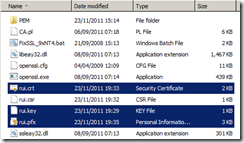
Read more…
 vCenter SSO gets one of the major updates. This is welcome news to anyone who installed SSO in vSphere 5.1 which was plagued with an overly complex and restrictive design. SSO in 5.1 was apparently an OEM component which VMware customised. SSO in 5.5 has been completely rewritten from the ground up internally.
vCenter SSO gets one of the major updates. This is welcome news to anyone who installed SSO in vSphere 5.1 which was plagued with an overly complex and restrictive design. SSO in 5.1 was apparently an OEM component which VMware customised. SSO in 5.5 has been completely rewritten from the ground up internally.














Recent Comments